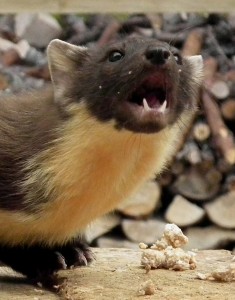 The re-introduction of animals and birds is widespread these days with many success stories such as the sea eagle, red kite, red squirrel and beaver. There is even talk of re-introducing the wolf to parts of Sutherland although this is still very much in the discussion stage. Re-introductions seems to be the “in word” although there is another word creeping in and it is “re-wilding”, although I for one hope this never catches on. Whatever the word that is used it embraces a great deal of effort and expense and a great deal of publicity. What many people tend to ignore or just not take into account is the follow-up with such re-introductions. There is no point in re-introducing if the results are not monitored and in some ways this costs as much as the original project. The sea-eagle is a good example, and there is a great deal of publicity about the project and in some parts it has become a tourist attraction of economic success for the tourist industry such as on the island of Mull. The intense and essential monitoring of the birds after the original re-introduction is often not mentioned in any of the publicity.
The re-introduction of animals and birds is widespread these days with many success stories such as the sea eagle, red kite, red squirrel and beaver. There is even talk of re-introducing the wolf to parts of Sutherland although this is still very much in the discussion stage. Re-introductions seems to be the “in word” although there is another word creeping in and it is “re-wilding”, although I for one hope this never catches on. Whatever the word that is used it embraces a great deal of effort and expense and a great deal of publicity. What many people tend to ignore or just not take into account is the follow-up with such re-introductions. There is no point in re-introducing if the results are not monitored and in some ways this costs as much as the original project. The sea-eagle is a good example, and there is a great deal of publicity about the project and in some parts it has become a tourist attraction of economic success for the tourist industry such as on the island of Mull. The intense and essential monitoring of the birds after the original re-introduction is often not mentioned in any of the publicity.
However, there are other sides to success stories in the wildlife conservation world, and one involves the pine marten. It is difficult to imagine these days that the pine marten at one time nearly went the way of the polecat, extinction. One element in this was the widespread felling of woodland but the overall problem was the intense persecution from all sides as the animals, along with many others from badgers to wildcats, were treated as vermin. Along with these, and others, they all had their bounties that were paid for each animal killed. This bounty list also included surprises such as red squirrels. Between 1903 and 1946 the Highland Squirrel Club killed 102,900 red squirrels for which the bounties or bonuses paid amounted to £1,504 which was a substantial sum in those days. There was another element with the pine marten persecution as their fur was much prized for clothing and was very lucrative to those who killed pine martens.
There was no plan to return the pine marten to its original numbers and distribution, but a series of almost unconnected events enabled the pine marten to hang on and they then started to increase in numbers and even extend their range. One element was the sudden decrease in persecution when the numbers of gamekeepers fell drastically as they answered the call of the two World Wars. Game shooting and rearing almost ceased completely and so the pine marten was left alone. Whilst to a certain extent the shooting recovered, the legislation to protect pine martens came in. Then there was the widespread planting of woodland, albeit mainly conifers, by the Forestry Commission and this helped the pine martens. Now the pine marten could well have returned to its former numbers in many parts of the Highlands and the latest surveys indicate it has now spread to south Scotland. They have been found in three new areas including one south and west of Glasgow. Islands have also been colonised such as the most recent arrival of pine marten on Mull. However, these delightful animals can still cause problems as I found out a few years ago when I had light Sussex hens taken in the garden. To put it into perspective it was my fault in not making sure the birds were secure overnight!
Tags: highland wildlife
